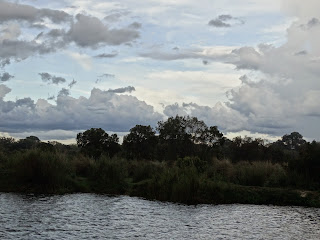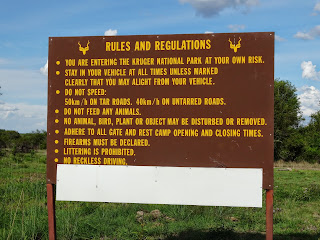Victoria Falls, Zimbabwe
On the day of our arrival in Victoria Falls,
Paolo had scheduled a sunset tour. We are in Victoria Falls for 3 nights but
no, this travel agent had to pack it in, all at once. We arrived at our hotel
at 2 pm and had to be ready for our pick up jitney at 4 pm for a river cruise;
one more item to rub Paolo’s nose into. A good travel agent can be a blessing
or like Paolo, a stumbling block to ones enjoyment. I don’t like to be rushed
from one event to the next.
 Our pickup at the Kingdom Hotel was on time at 4
pm, but like always on these tours, we had to visit 2 other hotels for additional
pickups. The weather looked threatening with rain clouds on the far horizon,
yet the small craft for our river cruise left from its docking place
regardless. It was tied not to a pier, but just at a spot somewhere along the Zambezi
River. The boat was tied up with long ropes to a few palm trees on top of the
bank. A group of dancers and singers,
Our pickup at the Kingdom Hotel was on time at 4
pm, but like always on these tours, we had to visit 2 other hotels for additional
pickups. The weather looked threatening with rain clouds on the far horizon,
yet the small craft for our river cruise left from its docking place
regardless. It was tied not to a pier, but just at a spot somewhere along the Zambezi
River. The boat was tied up with long ropes to a few palm trees on top of the
bank. A group of dancers and singers, again in imitation regalia, were set up to give us a send off while we struggled down the river bank using old car tires laid down as provisional steps on this perilous staircase. It felt improvised and temporary. Yet, the crew was all smiles and very friendly. Instructions were given to us in “English “on how to use the swim vests in case of a mishap. They forgot to show us however where those life vests were, just pointed to a spot on the lower deck, we were on the upper level. Included with this river tour were a free drinks (alcoholic or not) and some light snacks like peanuts and a kind of tapas.
 |
| Zambezi River |
alike; I found it difficult to find a visual reference. We were in search of any kind of wild life while nibbling on our snacks and sipping our drinks. Progress on the water is slow. Even though we hugged the river banks, no animals were to be seen.
Lightning now flashes in pairs and triples in the
distance, the temperature drops, the sky grows more ominously dark. Other
boats, similar to ours from all along the river, now converge in the hunt for
any kind of life along its bank. It feels like going fishing, sitting and
waiting for the big strike. A few raindrops start to fall but luckily the upper
deck has a roof, we are OK. The sky however tells me more rain will pour on us
soon. After some time of fruitless “hunting” for animal sights, we turn around
and head to our old docking spot. On the way back however, the captain tries one
of the side channels and sure enough a small
herd of hippos appears. The
animals are submerging and rising. Like whales, they appear, take a breath and
disappear almost immediately. Carol has more patience than I have and took some
pictures; it was difficult to even get those. One smaller hippo yawns, showing his
huge mouth; this is a scare tactic to frighten predators away.
 |
| Hippo |
Now it rains with the wind pelting us sideways,
the crew rushed to lower the canvas to give us some needed shelter.
The captain
turns the boat and heads back to his base, the dock near the Palm trees. The same
group of Dancers/Singers in their traditional regalia; are now singing loudly
for our welcome back. A rather stocky, large girl is showing off with high
kicks, a shaman dressed man stands near, looking bored. The rain stops, maybe
the Singers song worked. We did not see many animals, not even impala, normally the most abundant species in any park. We did not get any sunset pictures.
The sun, being obscured by the heavy rain
clouds, did not shine on us. We did
see hippos, not well, but then one cannot predict nature’s ways.
 |
| Hippo |
 |
| Shaman |
Back at the Hotel, after reading our choices of
activities, we decided to take a day off for some R&R and
booked 2 outings for the following, the 3rd day. Our start for the day was a
guided tour of the famous Victoria Falls. Since we are in a tropical region, we
decided on the earliest walking tour possible. So our pick up was at 8.30 am. We
could have walked to the National Park entrance but since Carol is not a good
walker and my colitis is acting up again, it is better we take the bus. The
admission to the falls is a stiff US $30. The temperature is already warm for
our taste. A large group of Japanese Tourists seem to shadow us; or do we shadow
them?
Our tour guide was a nice guy but did
little. One does not need a guide at
this park but he came with the booked tour.
The way along the falls is well marked and straight forward. There are
16 viewing points along the 1.6 km wide falls. The waters of the river fall into
a gorge that is twice as high as the Niagara Falls and the volume of water is
immense. We understood that the best time to see the full volume of water
pouring over the cliff is near the end of March, but what we saw was still impressive.
pouring over the cliff is near the end of March, but what we saw was still impressive.
 |
| Near the Devil's Pool |
 |
| The Devil's Pool |
amount of water where some daring people took a dip. Locals helped those daring tourists to get in and out of the devil’s pool using a rope. In the past some folks slipped and were never found, gone in the turmoil at the bottom of the gorge. What a fate.
This gorge, zig-zagging at the bottom of the
falls is narrow and deep and carries all the water of a 1.6 km wide river
compressed to maybe 300 meters width. The result is a tumultuous amount of
water. If you are daring you can go on a rubber raft ride down the gorge.
Even the advertising for this ride showed people flipping out of the zodiac kind
of craft, being thrown into the water. Sorry, not at my age, I’ll pass on these
‘adventures’. I
am not such a good swimmer anyhow, not even with a life vest
on. Our walk along the falls ended at viewpoint #16, where we saw the only
bridge spanning the Zambezi River for miles and miles around. This is the only bridge
to drive a car across. You can imagine that this road, this spot leading to the
bridge was busy. The old bridge, built in the colonial era, narrow and not built
for modern traffic, but still doing a good job, is a godsend. We are at the
end of our visit to the World famous Victoria Falls, now we must walk back,
through the jungle, to the starting point for our pick up, not along the falls
again. This is a ‘shortcut’ and is only 1.2 km long. Baboons are our companions. It is near 11 am
by the time we reach our bus and the temperature is near 30 C and
if feels humid and steamy. We have walked nearly 3 km on this tour. Not good for old bones like ours in heat and not feeling too well. Colitis is not a fun illness.
 |
| "Dr. Livingstone I Presume" |
if feels humid and steamy. We have walked nearly 3 km on this tour. Not good for old bones like ours in heat and not feeling too well. Colitis is not a fun illness.
Sure we could use a rest after walking that much
but we booked our next trip for 11 am. We opted for a birds eye view since the
area is rather flat. We booked a 12 minute helicopter ride, the cheapest ride possible
but still an astounding $ 140
US/each.
US/each.
But then I ask myself how many times will I come
here, this is a once in a lifetime experience. I have been on choppers before
and they serve a purpose, like a car. The pilot took us for a large figure
eight ride over the falls and then returned to base for his next 4 passengers. It
was like a bus ride, like a shuttle run. Yes it was a view from the top but the
walk along the falls was a better
experience. The good thing to see from above was how the gorge snakes its way away from the falls and turns into a river again.
experience. The good thing to see from above was how the gorge snakes its way away from the falls and turns into a river again.
We were done for the day, too hot; back to our AC
room at the “The Kingdom” Hotel for a siesta. My colitis is acting up again,
wonder what I ate that caused this. Travel is difficult if you can not eat what
is normally offered.

Tomorrow we are off to Chobe, Botswana.


















































